Tulip multiflora (Multiflora) is an unusually beautiful and extremely capricious plant. Despite this, once you see these flowers, you really want to experiment and grow such beauty on your site.
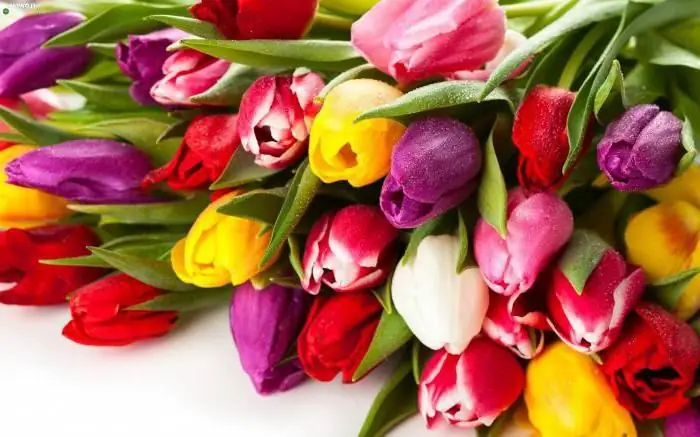
These tulips, which are often referred to as multi-stem, bush, bouquet, produce several magnificent flowers from one bulb.
Features of cultivation
The main problem of these plants is that the vast majority of varieties quickly degenerate. Often, the bulb pleases with its lush bouquet only in the first year. The next season, she gives two or three not very dense buds, which in the end may not even please you with flowering. To avoid this, it is necessary to properly care for multi-flowered tulips and choose well-established, proven varieties and quality planting material.
In order for the multi-flowered tulip to retain varietal characteristics, you should buy bulbs of the first analysis. This means that their diameter is preferably at least four centimeters. Smaller specimens are most often given"Blind" buds or already in the first season give only one very weak flower.

How to plant tulips in autumn?
Experienced flower growers know that autumn is the most important period in the life of all tulips, including multi-flowered ones. Although they are perennials, tulip bulbs should be repotted every year. This minimizes the risk of developing various diseases and stimulates the formation of he althy flower stalks.
How to plant tulips in autumn? This question is of interest to beginners in floriculture. This work is carried out in the second half of September or in the first days of October. For planting, it is necessary to choose a well-lit place with low groundwater, because if the bulbs are too wet, they may die.
Soil tulips need loose and light, with an alkaline neutral structure, as these plants do not tolerate acidic soils. Bulbs need to be prepared before planting. They should be kept for about an hour in a suspension of topsin-M or cineb. The solution is prepared at the rate of fifty grams of funds per bucket of water.
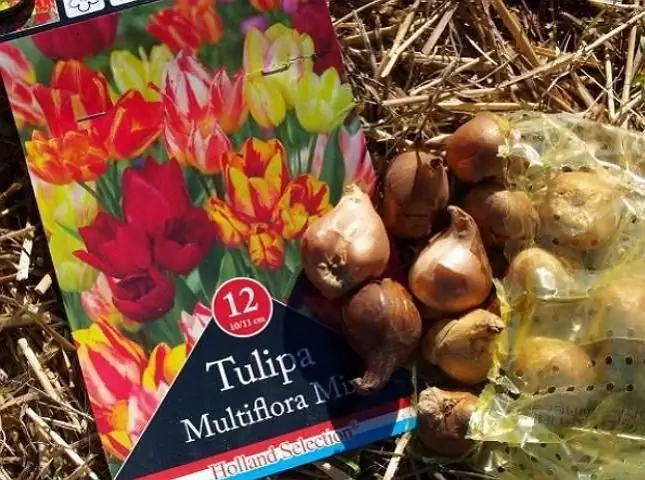
Tulip multiflorum should be planted at a depth that is two to three times the height of the bulb. As a rule, it is ten to twenty centimeters. Planting material must be carefully pressed into the loose earth at the bottom of the grooves, but in no case should it be screwed in. You should be especially careful with the bulb in October. During this period, the root roller swells and becomes brittle and vulnerable todamage.
For central Russia, the most suitable time for planting tulips is the second half of September. The temperature at this time is still quite high, there are many sunny days. The rooting of the plant begins at the moment when the temperature at the depth of the bulbs drops to + 4-9 degrees Celsius. In a dry autumn, after planting, the beds must be watered abundantly. To keep the soil warm for as long as possible and to maximize the rooting time of the bulbs, which is especially important when planting late, the ridges must be sprinkled with peat.
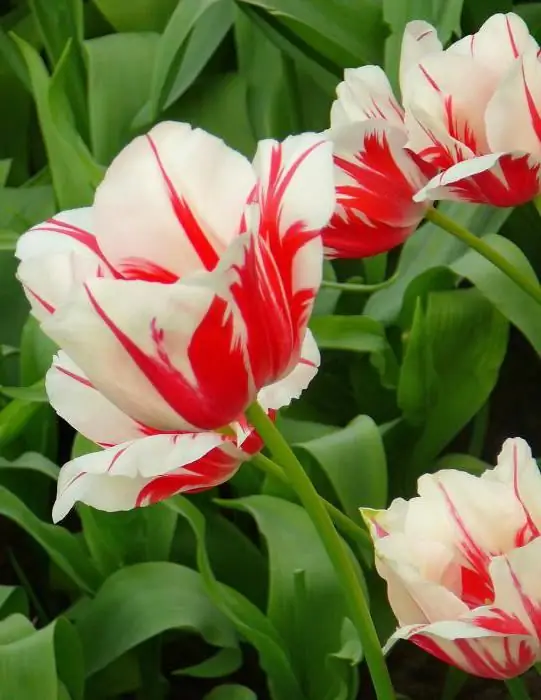
Soil
Two to three weeks before planting, you need to start preparing the soil for tulips. Digging the soil, mineral and organic fertilizers are introduced into it. Weathered peat and sand can be used to improve soil structure.
Irrigation
Tulip many-flowered - moisture-loving culture. If for many other types of tulips watering is not critical, then for bouquet varieties it is necessary. In the root zone, the soil should always be slightly moist - from early spring immediately after the snow has melted and until the very first buds appear. It is during dry times that the plant most often drops buds.
Feeding
Today, many flower growers dream of seeing a multi-flowered tulip on their plot. The description of well-known varieties, which is given by breeders, implies the obligatory feeding of these plants. Multi-flowered tulips need to be fed three times.
The first is held in early spring. To do this, use a complex mineral fertilizer, which is distributed under the plants at the rate of 40 grams per m². When the first buds appear, the second feeding is carried out. You can use the same fertilizer and do not change the dosage.
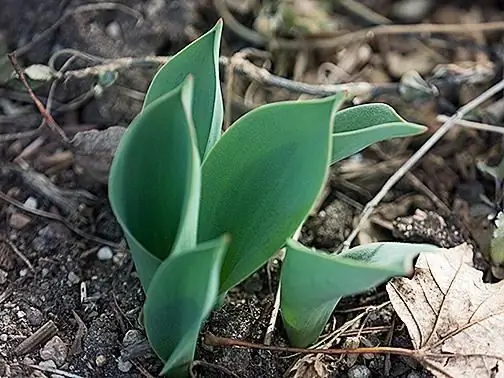
The third top dressing is carried out during flowering. At this time, tulips are watered with a solution of potassium monophosphate. It is necessary to dissolve a tablespoon of fertilizer in ten liters of water.
Care after the end of flowering
Tulip multiflora needs care even after flowering. The ovaries from the plants must be removed as soon as possible. Only the head should be removed, and the stem should not be broken off. When the aerial part of the plant turns yellow, multi-flowered tulips must be dug up. Unlike many other varieties, these plants need a longer dormant period. The first month they are kept warm (the temperature is about +30 degrees Celsius).
In August, the bulbs should be moved to a cooler place. Planting material must be cooled in stages. By the end of September, the bulbs must be stored at a temperature of +15 degrees.
Multicolor tulips: varieties
Today, a huge number of varieties and hybrids have been bred, and breeders continue to work on new plants. We will introduce you to popular and well-established varieties.
Antoinette
Great chameleon variety. Tulip Antoinette multi-flowered is distinguished by buds that change the color of the petals as they grow - frompale yellow to red. Up to six buds can bloom on one stem, forming an exquisite bouquet. The plant tolerates windy weather well and develops well in partial shade. Looks great in the flower bed and is suitable for cutting.

Candy Kisses
A variety that has unusually beautiful flowers with an original color. The petals of these tulips change color from pink at the base to peach at the edges. Up to six flower stalks grow from one bulb. Candy Kisses tulips are also attractive because they can be grown not only in a flower bed, but also as a pot crop.

Quebec
The Quebec tulip is not very tall. The bulb produces a small bouquet of two or three flowers. The buds of this plant are orange with a yellow border. The plant looks good in rock gardens, in a flower garden, in a container planting. Quebec tulips are among the first to bloom in spring, so we recommend including them in your collection.
Rosie Bouquet
Rosy Bouquet lives up to its name. A luxurious bouquet grows from one bulb of this variety. The buds are small, creamy white, with a thin pink edging of the petals.
Belicia
Terry multi-flowered early variety Belicia forms three to five flower stalks from one bulb. The flowers of this variety are luxurious cream bowls with scarlet edging. When the buds open fully, they resemble snowflakes with bright edges. These tulips don't grow too fast.
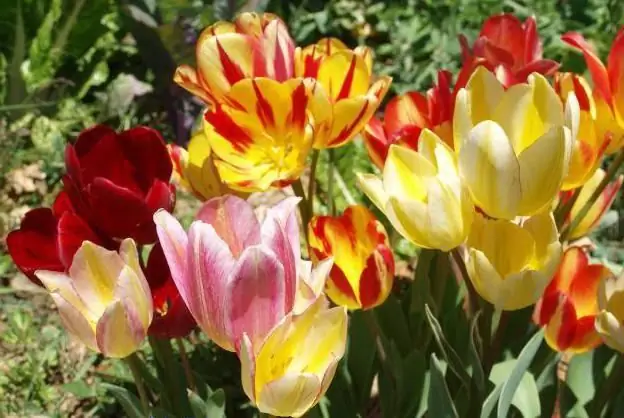
Fringid Family
The fringed, multi-flowered hot pink variety Fringed Family produces five to seven buds from one peduncle. The bright lilac-purple color of the flowers allows us to call the variety one of the most spectacular among the many-flowered. Ideal for flowerbeds and cut flowers.
Wallflower
This variety has very large buds. One bulb can produce up to five flowers. Their height reaches eight centimeters, and their diameter - up to sixteen centimeters. From these flowers, a simply stunning bouquet is obtained, despite the not too high height of the peduncles - no more than forty-five centimeters. Maroon buds.
Orange Bouquet
Very unusual variety with five peduncles. Buds can be geranium red or orange. The flowers have a yellow base, sometimes an orange border. The inner petals are red-pink. Tulips Orange Bouquet look great in the rock garden.






